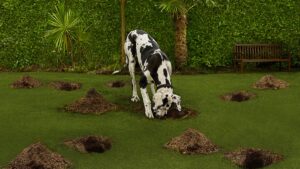This exciting Australian clay rare earths deposit has just doubled in size

Australian Rare Earths has discovered its already solid Koppamurra project is a lot bigger than anybody thought. Pic via Getty Images.
With the growing importance of rare earths, the 104% increase in resources at Australian Rare Earth’s Koppamurra project is well-timed indeed.
The ionic adsorption clay-hosted project – a type of REE mineralisation known for their ease of mining and processing that, until recently, was found primarily in Southern China and Myanmar – now has a resource of 81.4Mt grading 785 parts per million total rare earth oxides.
Most of this (+90%) is associated with the valuable magnet rare earths neodymium, praseodymium, terbium and dysprosium that are needed to produce high-strength permanent magnets used in electric vehicle motors and wind turbines.
Adding further interest for Australian Rare Earths (ASX:AR3), more than half the resource – or 45.4Mt at 835ppm TREO – is contained within the higher confidence Indicated category that can be used to guide mine planning.
Potential to further grow this resource can be found in the adjoining exploration targets totalling between 90Mt and 220Mt at 629ppm to 849ppm TREO, which covers just 5% of the company’s exploration tenure.
“This outstanding result is a game-changer because it elevates Koppamurra to the stage where its future as a globally significant project is now clear,” managing director Don Hyma says.
“Koppamurra is one of only three non-Chinese ionic clay-hosted rare earth deposits globally, and it is now emerging as a project of considerable scale and quality.
“Its key attributes include its Tier-1 jurisdiction location, a mineral assemblage that offers the potential to supply both the light and heavy rare earths required for high-strength permanent magnets, the shallow, free-digging nature of the mineralisation and a low-CAPEX development pathway that offers the potential for a modular, staged approach.”
Well located for development
Koppamurra covers more than 4,000km2 of ground on the boundary between South Australia and Victoria.
The shallow IAC-hosted mineralisation sits above the limestone aquifer, making it unlikely that any mining will interact with or impact groundwater in the region.
AR3’s resource upgrade incorporates the results of two completed drilling programs, which also highlighted a 30% increase in dry bulk density, potential 6km and 2km extensions to the north and south respectively, and record grades of up to 15,500ppm TREO.
Upcoming activity
The company plans to initiate a 10-20,000m drill program in the current quarter to further grow the resource footprint and upgrade the existing Indicated resource to the even higher confidence Measured category.
Hyma noted that this will be carried out in parallel with ongoing technical and metallurgical studies aimed at advancing Koppamurra towards development.
“Our vision is to progress down a pathway that will see Koppamurra in production by 2025/26, perfectly timed to take advantage of surging demand for rare earths,” he explained, adding that strong demand for neodymium iron boron (NdFeB) magnets in EVs and wind turbine generators is expected to lead to shortages as early as 2023.
Other work includes starting a Scoping Study in the fourth quarter of this year, carrying out environmental studies with a focus on groundwater and flora-fauna, and completing metallurgical testwork.
This article was developed in collaboration with Australian Rare Earths, a Stockhead advertiser at the time of publishing.
This article does not constitute financial product advice. You should consider obtaining independent advice before making any financial decisions.
Related Topics

UNLOCK INSIGHTS
Discover the untold stories of emerging ASX stocks.
Daily news and expert analysis, it's free to subscribe.
By proceeding, you confirm you understand that we handle personal information in accordance with our Privacy Policy.








